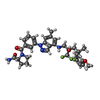Entry Database : PDB / ID : 3k23Title Glucocorticoid Receptor with Bound D-prolinamide 11 Glucocorticoid receptor Nuclear receptor coactivator 2 Keywords / / / / / / / / / / / / / / / / / / / Function / homology Function Domain/homology Component
/ / / / / / / / / / / / / / / / / / / / / / / / / / / / / / / / / / / / / / / / / / / / / / / / / / / / / / / / / / / / / / / / / / / / / / / / / / / / / / / / / / / / / / / / / / / / / / / / / / / / / / / / / / / / / / / / / / / / / / / / / / / / / / / / / / / / / / / / / / / / / / / / / / / / / / / / / / / / / / / Biological species Homo sapiens (human)Method / / / / Resolution : 3 Å Authors Biggadike, K.B. / McLay, I.M. / Madauss, K.P. / Williams, S.P. / Bledsoe, R.K. Journal : Proc.Natl.Acad.Sci.USA / Year : 2009Title : Design and x-ray crystal structures of high-potency nonsteroidal glucocorticoid agonists exploiting a novel binding site on the receptor.Authors: Biggadike, K. / Bledsoe, R.K. / Coe, D.M. / Cooper, T.W. / House, D. / Iannone, M.A. / Macdonald, S.J. / Madauss, K.P. / McLay, I.M. / Shipley, T.J. / Taylor, S.J. / Tran, T.B. / Uings, I.J. ... Authors : Biggadike, K. / Bledsoe, R.K. / Coe, D.M. / Cooper, T.W. / House, D. / Iannone, M.A. / Macdonald, S.J. / Madauss, K.P. / McLay, I.M. / Shipley, T.J. / Taylor, S.J. / Tran, T.B. / Uings, I.J. / Weller, V. / Williams, S.P. History Deposition Sep 29, 2009 Deposition site / Processing site Revision 1.0 Oct 27, 2009 Provider / Type Revision 1.1 Jul 13, 2011 Group / Refinement description / Version format complianceRevision 1.2 Nov 1, 2017 Group / Category Revision 1.3 Oct 13, 2021 Group / Derived calculations / Category / struct_ref_seq_dif / struct_siteItem _database_2.pdbx_DOI / _database_2.pdbx_database_accession ... _database_2.pdbx_DOI / _database_2.pdbx_database_accession / _struct_ref_seq_dif.details / _struct_site.pdbx_auth_asym_id / _struct_site.pdbx_auth_comp_id / _struct_site.pdbx_auth_seq_id Revision 1.4 Feb 21, 2024 Group / Category / chem_comp_bondRevision 1.5 Apr 3, 2024 Group / Category
Show all Show less
 Open data
Open data Basic information
Basic information Components
Components Keywords
Keywords TRANSCRIPTION /
TRANSCRIPTION /  Glucocorticoid Receptor /
Glucocorticoid Receptor /  Steroid Hormone Receptor /
Steroid Hormone Receptor /  Nuclear Receptor / GR /
Nuclear Receptor / GR /  glucocorticoids / alpha helical sandwich / meta-channel / Alternative initiation / Chromatin regulator / Disease mutation / DNA-binding / Metal-binding /
glucocorticoids / alpha helical sandwich / meta-channel / Alternative initiation / Chromatin regulator / Disease mutation / DNA-binding / Metal-binding /  Nucleus /
Nucleus /  Pseudohermaphroditism / Receptor / Steroid-binding /
Pseudohermaphroditism / Receptor / Steroid-binding /  Transcription regulation /
Transcription regulation /  Zinc-finger / Activator
Zinc-finger / Activator Function and homology information
Function and homology information steroid hormone binding / PTK6 Expression / glucocorticoid metabolic process / neuroinflammatory response / microglia differentiation /
steroid hormone binding / PTK6 Expression / glucocorticoid metabolic process / neuroinflammatory response / microglia differentiation /  maternal behavior / mammary gland duct morphogenesis ...Regulation of NPAS4 gene transcription / regulation of glucocorticoid biosynthetic process / nuclear glucocorticoid receptor activity /
maternal behavior / mammary gland duct morphogenesis ...Regulation of NPAS4 gene transcription / regulation of glucocorticoid biosynthetic process / nuclear glucocorticoid receptor activity /  steroid hormone binding / PTK6 Expression / glucocorticoid metabolic process / neuroinflammatory response / microglia differentiation /
steroid hormone binding / PTK6 Expression / glucocorticoid metabolic process / neuroinflammatory response / microglia differentiation /  maternal behavior / mammary gland duct morphogenesis / nucleus localization / astrocyte differentiation / cellular response to glucocorticoid stimulus /
maternal behavior / mammary gland duct morphogenesis / nucleus localization / astrocyte differentiation / cellular response to glucocorticoid stimulus /  motor behavior /
motor behavior /  regulation of gluconeogenesis / adrenal gland development / RNA polymerase II intronic transcription regulatory region sequence-specific DNA binding / cellular response to steroid hormone stimulus / locomotor rhythm /
regulation of gluconeogenesis / adrenal gland development / RNA polymerase II intronic transcription regulatory region sequence-specific DNA binding / cellular response to steroid hormone stimulus / locomotor rhythm /  aryl hydrocarbon receptor binding / regulation of lipid metabolic process / cellular response to Thyroglobulin triiodothyronine / regulation of glucose metabolic process / Synthesis of bile acids and bile salts / Endogenous sterols / Synthesis of bile acids and bile salts via 27-hydroxycholesterol /
aryl hydrocarbon receptor binding / regulation of lipid metabolic process / cellular response to Thyroglobulin triiodothyronine / regulation of glucose metabolic process / Synthesis of bile acids and bile salts / Endogenous sterols / Synthesis of bile acids and bile salts via 27-hydroxycholesterol /  estrogen response element binding / FOXO-mediated transcription of oxidative stress, metabolic and neuronal genes / Synthesis of bile acids and bile salts via 7alpha-hydroxycholesterol / intracellular steroid hormone receptor signaling pathway / core promoter sequence-specific DNA binding / Recycling of bile acids and salts / regulation of cellular response to insulin stimulus / cellular response to hormone stimulus / cellular response to transforming growth factor beta stimulus / positive regulation of adipose tissue development / HSP90 chaperone cycle for steroid hormone receptors (SHR) in the presence of ligand / peroxisome proliferator activated receptor signaling pathway / RORA activates gene expression / TBP-class protein binding / Regulation of lipid metabolism by PPARalpha /
estrogen response element binding / FOXO-mediated transcription of oxidative stress, metabolic and neuronal genes / Synthesis of bile acids and bile salts via 7alpha-hydroxycholesterol / intracellular steroid hormone receptor signaling pathway / core promoter sequence-specific DNA binding / Recycling of bile acids and salts / regulation of cellular response to insulin stimulus / cellular response to hormone stimulus / cellular response to transforming growth factor beta stimulus / positive regulation of adipose tissue development / HSP90 chaperone cycle for steroid hormone receptors (SHR) in the presence of ligand / peroxisome proliferator activated receptor signaling pathway / RORA activates gene expression / TBP-class protein binding / Regulation of lipid metabolism by PPARalpha /  steroid binding / cellular response to dexamethasone stimulus / BMAL1:CLOCK,NPAS2 activates circadian gene expression / nuclear receptor coactivator activity / SUMOylation of transcription cofactors / Activation of gene expression by SREBF (SREBP) / response to progesterone /
steroid binding / cellular response to dexamethasone stimulus / BMAL1:CLOCK,NPAS2 activates circadian gene expression / nuclear receptor coactivator activity / SUMOylation of transcription cofactors / Activation of gene expression by SREBF (SREBP) / response to progesterone /  synaptic transmission, glutamatergic /
synaptic transmission, glutamatergic /  chromosome segregation /
chromosome segregation /  nuclear receptor binding / RNA polymerase II transcription regulatory region sequence-specific DNA binding /
nuclear receptor binding / RNA polymerase II transcription regulatory region sequence-specific DNA binding /  Hsp90 protein binding / circadian regulation of gene expression / Heme signaling / SUMOylation of intracellular receptors / mRNA transcription by RNA polymerase II / Activated PKN1 stimulates transcription of AR (androgen receptor) regulated genes KLK2 and KLK3 / Transcriptional activation of mitochondrial biogenesis / PPARA activates gene expression / Cytoprotection by HMOX1 / spindle / DNA-binding transcription repressor activity, RNA polymerase II-specific / Transcriptional regulation of white adipocyte differentiation / positive regulation of miRNA transcription / Nuclear Receptor transcription pathway / RNA polymerase II transcription regulator complex / positive regulation of neuron apoptotic process / Regulation of RUNX2 expression and activity /
Hsp90 protein binding / circadian regulation of gene expression / Heme signaling / SUMOylation of intracellular receptors / mRNA transcription by RNA polymerase II / Activated PKN1 stimulates transcription of AR (androgen receptor) regulated genes KLK2 and KLK3 / Transcriptional activation of mitochondrial biogenesis / PPARA activates gene expression / Cytoprotection by HMOX1 / spindle / DNA-binding transcription repressor activity, RNA polymerase II-specific / Transcriptional regulation of white adipocyte differentiation / positive regulation of miRNA transcription / Nuclear Receptor transcription pathway / RNA polymerase II transcription regulator complex / positive regulation of neuron apoptotic process / Regulation of RUNX2 expression and activity /  nuclear receptor activity /
nuclear receptor activity /  Circadian Clock / sequence-specific double-stranded DNA binding /
Circadian Clock / sequence-specific double-stranded DNA binding /  gene expression / chromatin organization / HATs acetylate histones / DNA-binding transcription activator activity, RNA polymerase II-specific / Estrogen-dependent gene expression /
gene expression / chromatin organization / HATs acetylate histones / DNA-binding transcription activator activity, RNA polymerase II-specific / Estrogen-dependent gene expression /  transcription regulator complex / Potential therapeutics for SARS /
transcription regulator complex / Potential therapeutics for SARS /  transcription coactivator activity /
transcription coactivator activity /  protein dimerization activity /
protein dimerization activity /  nuclear body / DNA-binding transcription factor activity, RNA polymerase II-specific /
nuclear body / DNA-binding transcription factor activity, RNA polymerase II-specific /  mitochondrial matrix / nuclear speck / RNA polymerase II cis-regulatory region sequence-specific DNA binding / DNA-binding transcription factor activity /
mitochondrial matrix / nuclear speck / RNA polymerase II cis-regulatory region sequence-specific DNA binding / DNA-binding transcription factor activity /  cell division / protein domain specific binding /
cell division / protein domain specific binding /  centrosome / negative regulation of DNA-templated transcription /
centrosome / negative regulation of DNA-templated transcription /  synapse / apoptotic process /
synapse / apoptotic process /  chromatin binding /
chromatin binding /  chromatin / regulation of DNA-templated transcription / regulation of transcription by RNA polymerase II /
chromatin / regulation of DNA-templated transcription / regulation of transcription by RNA polymerase II /  protein kinase binding / negative regulation of transcription by RNA polymerase II /
protein kinase binding / negative regulation of transcription by RNA polymerase II /  signal transduction
signal transduction
 Homo sapiens (human)
Homo sapiens (human) X-RAY DIFFRACTION /
X-RAY DIFFRACTION /  SYNCHROTRON /
SYNCHROTRON /  MOLECULAR REPLACEMENT /
MOLECULAR REPLACEMENT /  molecular replacement / Resolution: 3 Å
molecular replacement / Resolution: 3 Å  Authors
Authors Citation
Citation Journal: Proc.Natl.Acad.Sci.USA / Year: 2009
Journal: Proc.Natl.Acad.Sci.USA / Year: 2009 Structure visualization
Structure visualization Molmil
Molmil Jmol/JSmol
Jmol/JSmol Downloads & links
Downloads & links Download
Download 3k23.cif.gz
3k23.cif.gz PDBx/mmCIF format
PDBx/mmCIF format pdb3k23.ent.gz
pdb3k23.ent.gz PDB format
PDB format 3k23.json.gz
3k23.json.gz PDBx/mmJSON format
PDBx/mmJSON format Other downloads
Other downloads https://data.pdbj.org/pub/pdb/validation_reports/k2/3k23
https://data.pdbj.org/pub/pdb/validation_reports/k2/3k23 ftp://data.pdbj.org/pub/pdb/validation_reports/k2/3k23
ftp://data.pdbj.org/pub/pdb/validation_reports/k2/3k23 Links
Links Assembly
Assembly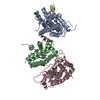
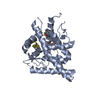
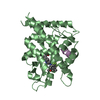
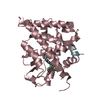
 Components
Components / GR / Nuclear receptor subfamily 3 group C member 1
/ GR / Nuclear receptor subfamily 3 group C member 1
 Homo sapiens (human) / Gene: GRL, NR3C1 / Plasmid: pHis GST / Production host:
Homo sapiens (human) / Gene: GRL, NR3C1 / Plasmid: pHis GST / Production host: 
 Escherichia coli (E. coli) / Strain (production host): BL21(DE3) / References: UniProt: P04150
Escherichia coli (E. coli) / Strain (production host): BL21(DE3) / References: UniProt: P04150 / NCoA-2 / Transcriptional intermediary factor 2 / hTIF2
/ NCoA-2 / Transcriptional intermediary factor 2 / hTIF2 Water
Water X-RAY DIFFRACTION / Number of used crystals: 1
X-RAY DIFFRACTION / Number of used crystals: 1  Sample preparation
Sample preparation
 SYNCHROTRON / Site:
SYNCHROTRON / Site:  APS
APS  / Beamline: 17-ID / Wavelength: 1 Å
/ Beamline: 17-ID / Wavelength: 1 Å : 1 Å / Relative weight: 1
: 1 Å / Relative weight: 1 
 molecular replacement
molecular replacement Processing
Processing :
:  MOLECULAR REPLACEMENT
MOLECULAR REPLACEMENT Movie
Movie Controller
Controller




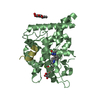

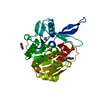
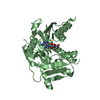
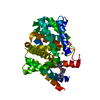
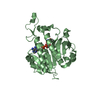
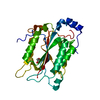


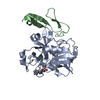
 PDBj
PDBj
















